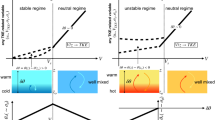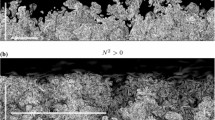Abstract
We have carried out a theoretical study of the simplest possible, second-order, chemical destruction process in the atmospheric surface layer. The model describes the destruction of two gases emanating from the surface with the same molecular flux. Although this situation seems artificial with no counterpart in the real atmosphere, the results shed light on some fundamental problems. For example, it is possible to specify boundary conditions, with the concentrations and the fluxes at a given height away from the surface, which lead to unrealistic solutions with infinite surface fluxes. A method to describe and separate the consistent solutions for this process was developed. It is in general of particular interest from an experimental point of view since it is not possible to measure fluxes right at the surface: if a measurement of flux and concentration in a given height requires infinite surface fluxes there is something wrong with the data. We expect that such problems will be inherent in more complex reactions schemes, such as the NO-NO2-O3 triad. Just as in first-order destruction processes, the Damköhler ratio will enter the turbulent diffusivity, but where this ratio is concentration independent for first-order processes, the present second-order model implies that the Damköhler ratio is proportional to the concentration. In the study of first-order processes it was found that the Damköhler correction to the turbulent diffusivity is of minor importance from an experimental point of view. We arrive at the same conclusion in this particularly simple study of second-order destruction. In other words, this work may be considered a further development of a previous study of the first-order destruction of a passive scalar. The model and the method we develop to solve the corresponding nonlinear differential equations are considered a preliminary study for developing tools to deal with more complicated atmospheric processes. Also, the results obtained may serve as a “calibration case” for more elaborate simulations.
Similar content being viewed by others
References
Countess, R. J. and Heicklen, J., 1973: Kinetics of particle growth. II. Kinetics of the reaction of ammonia with hydrogen chloride and the growth of particulate ammonium chloride, J. Phys. Chem. 77, 444–447.
Druilhet, A., Guedalia, D., Fontan, J., and Laurant, J., 1972: Study of radon 220 emanation deduced from measurement of vertical profiles in the atmosphere, J. Geophys. Res. 77, 6508–6514.
Fitzjarrald, D. R. and Lenschow, D. H.,1983: Mean concentration and flux profiles for chemically reactive species in the atmospheric surface layer, Atmos. Environ. 17, 2505–2512.
Kristensen, L., Andersen, C. E., Jørgensen, H. E., Kirkegaard, P., and Pilegaard, K., 1997: First-order chemistry in the surface-flux layer, J. Atmos. Chem. 27, 249–269.
Leighton, P. A., 1961: Photochemistry of Air Pollution, Academic Press, New York, pp. 300.
Lenschow, D. H. and Delany, A. C., 1987: An analytic formulation of NO and NO$_2$ flux profiles in the atmospheric surface layer, J. Atmos. Chem. 5, 301–309.
Luria, M. and Cohen, B., 1980: Kinetics of gas to particle conversion in the NH$_3$ – HCl system, Atmos. Environ. 14, 665–670.
Neufeld, Z., Haynes, P. H., and Tél, T., 2002: Chaotic mixing induced transitions in reaction–diffusion systems, CHAOS 12, 426–438.
Panofsky, H. A. and Dutton, J. A., 1984: Atmospheric Turbulence: Models and Methods for Engineering Applications, John Wiley & Sons, Inc., New York, pp. 397.
Pope, S. B., 2000: Turbulent Flows, Cambridge University Press, New York, NY, pp. 771.
Stockwell, W. R., 1995: Effects of turbulence on gas-phase atmospheric chemistry: Calculation of the relationship between time scales for diffusion and chemical reaction, Meteorol. Atmos. Phys. 57, 159–171.
Vilà-Guerau de Arellano, J. and Duynkerke, P. G., 1992: Influence of chemistry on fluxgradient relationships for the NO-O3-NO2 system, Boundary-Layer Meteorol. 61, 375–387.
Vilà-Guerau de Arellano, J., Duynkerke, P. G., and Keller, K. F., 1995: Atmospheric surface layer similarity theory applied to chemically reactive species, J. Geophys. Res. 100, 1397–1408.
Wyngaard, J. C., 1982: Boundary-layer modeling, in F. T. M. Nieuwstadt and H. van Dop, (eds), Atmospheric Turbulence and Air Pollution Modeling, D. Reidel publishing company, dordrecht, Holland, Boston, U.S.A., London, England, chapter 3, 69–106.
Author information
Authors and Affiliations
Corresponding author
Rights and permissions
About this article
Cite this article
Kristensen, L., Kirkegaard, P. Fluxes and Concentrations of Non-Conserved Scalars in the Atmospheric Surface Layer. J Atmos Chem 53, 251–263 (2006). https://doi.org/10.1007/s10874-006-9016-z
Received:
Accepted:
Published:
Issue Date:
DOI: https://doi.org/10.1007/s10874-006-9016-z




